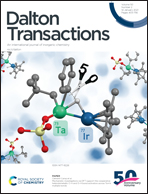Electronic and geometric structure effects on one-electron oxidation of first-row transition metals in the same ligand framework†
Abstract
Developing new transition metal catalysts requires understanding of how both metal and ligand properties determine reactivity. Since metal complexes bearing ligands of the Py5 family (2,6-bis-[(2-pyridyl)methyl]pyridine) have been employed in many fields in the past 20 years, we set out here to understand their redox properties by studying a series of base metal ions (M = Mn, Fe, Co, and Ni) within the Py5OH (pyridine-2,6-diylbis[di-(pyridin-2-yl)methanol]) variant. Both reduced (MII) and the one-electron oxidized (MIII) species were carefully characterized using a combination of X-ray crystallography, X-ray absorption spectroscopy, cyclic voltammetry, and density-functional theory calculations. The observed metal–ligand interactions and electrochemical properties do not always follow consistent trends along the periodic table. We demonstrate that this observation cannot be explained by only considering orbital and geometric relaxation, and that spin multiplicity changes needed to be included into the DFT calculations to reproduce and understand these trends. In addition, exchange reactions of the sixth ligand coordinated to the metal, were analysed. Finally, by including published data of the extensively characterised Py5OMe (pyridine-2,6-diylbis[di-(pyridin-2-yl)methoxymethane])complexes, the special characteristics of the less common Py5OH ligand were extracted. This comparison highlights the non-innocent effect of the distal OH functionalization on the geometry, and consequently on the electronic structure of the metal complexes. Together, this gives a complete analysis of metal and ligand degrees of freedom for these base metal complexes, while also providing general insights into how to control electrochemical processes of transition metal complexes.



 Please wait while we load your content...
Please wait while we load your content...